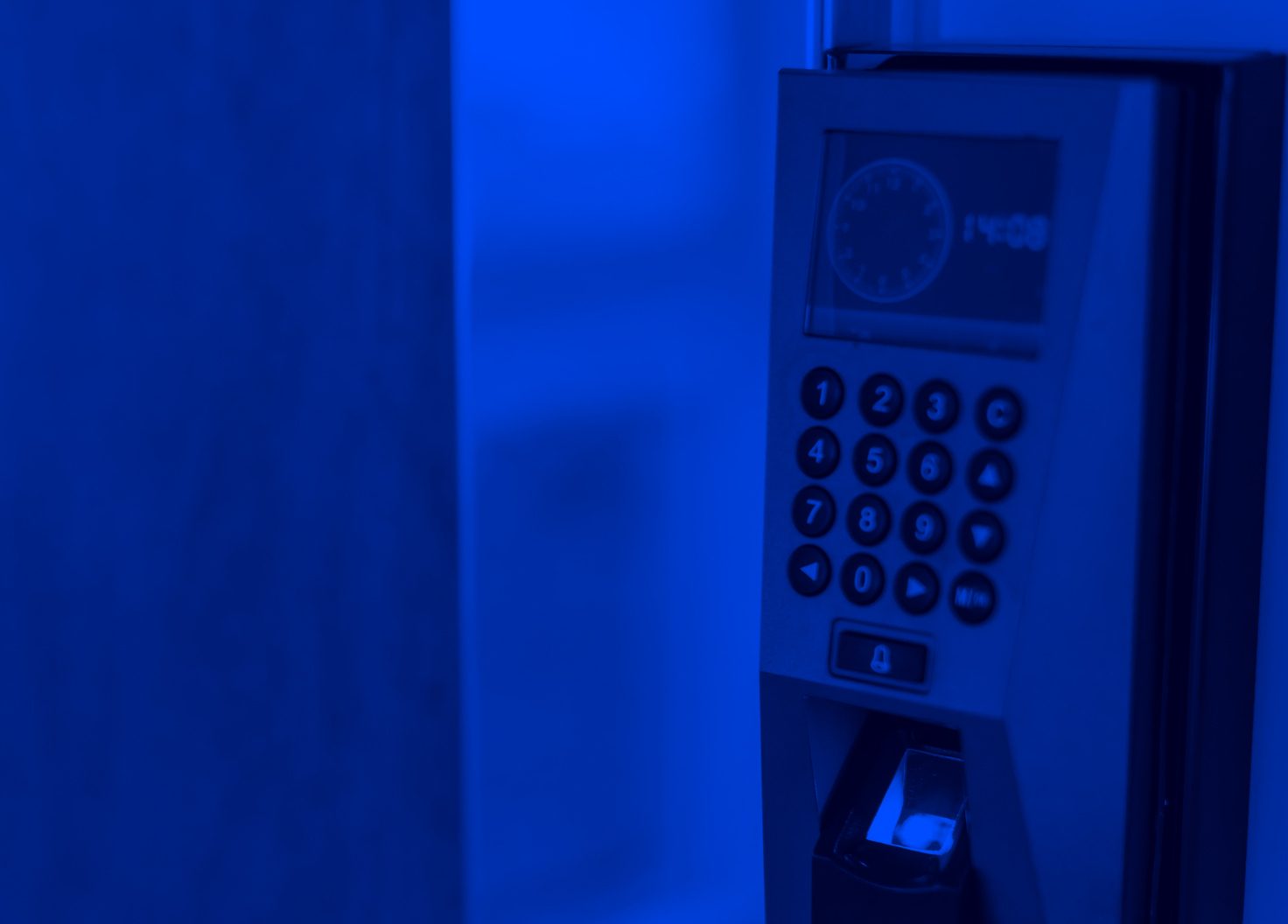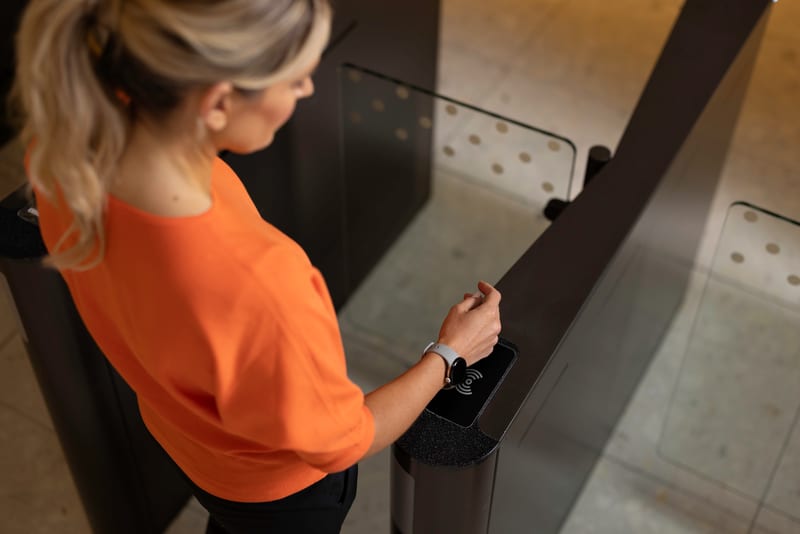april 2025
// SDM EXCLUSIVE

Sponsored by:
State of the Market:
Access Control Trends Moving the Market Forward
A comprehensive overview of manufacturer and dealer/integrator viewpoints on access control in 2024 and their predictions for how the market will perform in 2025.

By Christopher Crumley, SDM Associate Editor


Tim McHugh, business development director, Integrated Protection Services, and Taylor Neal, marketing manager, Integrated Protection Services. Images courtesy of Integrated Protection Services.
Background image zneal / Creatas Video / Getty Images Plus / via Getty Images
SHARE
Across the board, manufacturers and security integrators reported a strong 2024. If they didn’t share that their organization experienced growth, they indicated that their performance was steady in the access control market. In SDM’s 2025 Industry Forecast, 86 percent of respondents indicated that their perception of the access control market was “good to excellent.”
So what’s benefiting the market? For one, Angelo Faenza, head of digital access solutions, ASSA ABLOY Opening Solutions Americas, New Haven, Conn., points to end users’ increased awareness of and experience with the technology available to them. “The best news is that we’ve seen end users become more sophisticated and informed about these solutions,” he says. “They’ve done more research than I’ve ever seen in my career. They’ve done their homework. And we’ve also been a resource for them as partners. While we never sell directly to an end user, we do spend time helping them learn about the technology and the options that are available.”
This is a trend that’s become increasingly relevant over the past few years as end users get familiar with facial recognition, wallet-based credentials, and a general relationship to using mobile apps for traditionally sensitive transactions like banking and paying bills. Users are aware that the industry has moved past just physical key cards.
“What’s interesting to me is that we in this industry understand what security and access control are, but traditionally most of our friends and colleagues have no idea what it is or what to look for,” Faenza continues. “But in the last few years, many people I know are asking, ‘Hey, my daughter’s going to college, my son’s going to college, what do we look for when it comes to security on campus and in their dorm?’ Nobody really asked that question 10 years ago. It’s a really good sign for our industry that parents and other people are thinking about it.”
2024 Trends: As-a-Service & In the Cloud Dominated
There are a few technological trends that have pushed growth — and user excitement — over the last year. Credentials going mobile, solutions being deployed in the cloud, and the shift towards “as-a-service” are a handful of the most top-of-mind tech trends, and experts expect these technologies are here to stay. “I predict more as-a-service solutions,” says Tina D’Agostin, CEO, Alcatraz AI, Cupertino, Calif. “In the physical security segment, there’s more adaptation of buyers thinking about security not as (capital expense) CapEx, but more as (operational expense) OpEx, so that they continuously can be improving and adapting their technologies.”
SDM Industry Forecast Survey respondents were also bullish on “as-a-service” offerings, with 65 percent saying they currently offer access control as a service, and even more (73 percent) currently offering managed access control.
Of those surveyed for SDM’s Industry Forecast, 61 percent expect revenue from access control systems (on-premise and cloud-based) to increase in 2025 and 35 percent expect it to remain the same. Just 4 percent expect revenue to decrease. // Source: SDM 2025 Industry Forecast Study
Sixty-one percent of the respondents to the SDM 2025 Forecast (conducted in November 2024) rated their confidence in the access control market as “very good or excellent,” up 9 percentage points from last year. Another 25 percent rated the market as “good,” with just 14 percent rating it as “fair” or “poor.” // Source: SDM 2024 and 2025 Industry Forecast Studies
D’Agostin says Alcatraz AI saw increased as-a-service adoption. “It’s where we continue to see growth and we expect it to continue in 2025. The speed at which security technology is moving, hardware can be outdated before you even hang it on the wall. So we designed an as-a-service model so that companies’ access control and biometric solutions at the edge evolve with the ever-changing threat and compliance landscape. We’re a full stack platform that makes our customers future ready, and they appreciate that proposition.
“I would predict more as-a-service solutions in the physical security segment,” D’Agostin continues. “Technology is moving at an unprecedented speed, and customers can’t afford to invest in technologies that remain stagnant. An as-a-service model is the way to ensure that they’re future ready.”
The ease of entry into the world of recurring monthly revenue — the as-a-service model — goes hand-in-hand with the rise of cloud-based solutions. This combination fosters a closer, stickier and more long-term relationship between the end user and the integrator.
“The cloud service has really been a game changer,” says Tim McHugh, business development director, Integrated Protection Services, Lexington, Ky., featured on this month’s cover along with Taylor Neal. “That’s probably been the single biggest impact. I would say that even over the last three years, our customers have been much more receptive to a cloud-based access control platform and the subscription model that goes with that. They’ve really become much more accepting, no longer wanting to just do things as a CapEx and just hope that it lasts 10-15 years. They love the flexibility that the cloud brings. They love the ease of managing the system remotely, as well as just the ease of being able to update things wherever and at any time you want to.”
Aaron Black, vice president of sales, Napco Access Pro, Amityville, N.Y., emphasizes the strength of cloud-based solutions, saying, “The biggest opportunity is the cloud adaptation that the market is seeing. You’re starting to see more and more dealers install a cloud-based system instead of a traditional on-prem system.”
The best news is that we’ve seen end users become more sophisticated and informed about these solutions,” he says. “They’ve done more research than I’ve ever seen in my career. They’ve done their homework.
— Angelo Faenza, ASSA ABLOY
86% of Forecast respondents rate the access control market as good to excellent.
Source: SDM 2025 Industry Forecast Study

86%

Facial biometrics provide a convenient and frictionless form of authentication. Image courtesy of Alcatraz AI
Labor Concerns & Labor’s Value
Another challenge for the market is a potential talent shortage. Reasons range from the existing pool of professionals aging to a lack of awareness among younger folks. Whatever the reason may be, the industry is responding with quite a few initiatives. “I think when I talk to integrators, especially those contract hardware distributors that have become integrators, the number one thing is probably labor,” ASSA ABLOY’s Angelo Faenza says. “We have a shortage of labor in general. Unemployment is roughly around 4 percent. And people don’t really know our industry. So, when a young person thinks about going to a trade school, they typically think of plumbing, electrical, HVAC, and other building trades, but they don't think about becoming an integrator.
“That’s the hard news,” he continues. “But I think the good news is more and more integrators are working to change this in their local communities, by going to local high schools and local trade schools, letting them know the industry exists. Certainly, the Security Industry Association (SIA) has been involved, and so has the door and hardware industry. We also have fantastic training programs at ASSA ABLOY. Getting training for the door security workforce is essential, because installation on a new project is just part one.”
Sage’s John Nemerofsky echoes this, saying, “The biggest challenge continues to be workforce development and finding new people to enter the industry to deploy these systems. Kids coming out of high school can get certified in auto-mechanics or plumbing or electrical or carpentry. We’re working with a foundation called FAST (SIA’s Foundation for Advancing Security Talent) to build that same type of education through 900 high schools throughout the country. When these kids get out of high school they could potentially be Honeywell certified or Software House certified or Lenel certified or Genetec certified. So we’re trying to do some things to make it easier to bring new young talent in.”
Faenza goes on to say, “We’ve talked about this at length over the years — we’re a graying industry. So, if you’re a young person who loves to work with your hands and you’re skilled, you could have a remarkable and profitable career in an industry that has been so kind and good to so many of us. That’s why I believe labor is simultaneously the biggest challenge for the industry and the greatest opportunity for those who would like to join us. It’s a highly valuable, rewarding, and exciting way to make a living while keeping people and places safe and secure in the process.”
--There’s also a tremendous opportunity in modernizing end users’ access control systems. “With the legacy on-premise customers, users are asking us, ‘How do we roadmap this? How can we set a transition path?’ And they’re really trying to fully understand the logistics of doing that,” says Ryan Knoll, account executive, Pro-Tech Design, Santa Fe Springs, Calif. “With that focus, some of the partners we brought on offer the functionality to flash existing hardware. It’s not going to be a complete rip and replace, which a lot of times is a huge hurdle for organizations, especially if you start getting into hundreds of doors and multiple locations. As long as you’re on the standard hardware, we can go out there and say, ‘It’s labor only.’ We can handle the user migration. We’ll go out and flash the boards and you’re up and running and you can use all your existing hardware. That’s huge.”
Experts say the ease of leveraging benefits of remaining up-to-date with as-a-service solutions have contributed to the market’s growth because of how clear the gains are for the user. “We made a push to try to get service agreements in place for some of our on-prem access control deployments,” McHugh says. “They hadn’t been updated in a long time, so we needed to send a tech out to update a piece of equipment. We came to see a five year cycle of a server not having enough computing power. So if you go back five years, we had some tough conversations with customers informing them that we couldn’t modernize them with the server they had in place. It doesn’t have enough computing power associated with it, so you’re going to have to go buy a new server and modernize it. Then we’ll come on out to get you on an updated system. Now, we’re having the same conversation with some of the same customers. We’re talking to them about how we’d love to put them on the current version, but you don’t have enough computing horsepower. Those conversations for upgrades are becoming very easy for us to say, ‘Let’s look at going cloud-based. You don’t have to be in this predicament again.’”
Integration & Consolidation
Another huge trend that continued through 2024 and is expected to extend beyond 2025 is that of the convergence of technology. If not total convergence, then solutions are at least increasing their integrations with other technologies. “Integration is huge right now,” says Rob Druktenis, program manager, access control, Axis Communications, Chelmsford, Mass. “I see a transition in the market where users are trying to consolidate all the different hardware platforms for all the different software platforms they’re on. There’s integration from the software side of things and also from the hardware side. At Axis, we’re huge on end-to-end solutions, and because we have a VMS platform that has access control already built in, there aren’t any extra fees or costs that we have to associate if a customer says they want to add access control. It’s pretty seamless. It’s just a simple device license they have to add and they can start adding doors.”
Warren Hill, executive director of product management, Digital Monitoring Products (DMP), Springfield, Mo., highlights the benefits of these technologies converging. “Another thing I want to emphasize is just the marrying of video with access control [and] when doors are accessed, being able to see and visually verify if the person that accessed that door was who their credentials said they are. Video also enables us to use more of that intelligence to analyze right up front before access is actually granted.”
Knoll draws attention to the integrations that have been enabled by cloud technology. These integrations have driven growth, as they allow access control systems to interface with other building management capabilities, which is something the end user desires. “I think that has really been the big driver for us especially as those integrations are starting to touch other areas of their business. It’s not just how do we allow our employees to open and close the door? It’s also how can we use our data and leverage that to get other increased functionality, whether that be through things like the HVAC system or booking meeting rooms and managing visitors? Embracing cloud and cloud adoption just continues to go up and up.”
From the integrator perspective, Roy Stephenson, director of business development, Utah Yamas Controls, Salt Lake City, agrees with this sentiment. “I think the integration of access control and video surveillance will continue, and that behavioral analytics will be used to identify threats and suspicious activity,” he says. “I think that’s going to be pushing some innovations in the industry, especially as more and more things go online, and everything becomes cloud-based. That information that we store and gather with the access control systems and video surveillance is becoming a major commodity. And that information can be used to create more secure buildings.”
A move away from proprietary solutions and towards interoperable credentials is another related trend. End users are increasingly showing interest in freedom and flexibility in the access market. “There’s a desire among end users for having their device credentials and systems be interoperable,” says Ben Brydges, executive vice president, dormakaba North America, Indianapolis. “Users want to have those choices and the freedom of choice in terms of devices and credentials. But with that you have to wonder, am I then sacrificing security because I’m giving up a proprietary air-tight system? There’s a balance and we need to take a look at that and educate everybody on the trade-offs for all of those things.”
Education Sector Drives Growth
There’s one vertical that experts indicated substantial growth in more than any other: education. In this sector, aging systems, regulation compliance, and an increase in active shooter events have driven growth. “We started to get more requests for the ability to support wireless lock sets,” Druktenis says. “There are more and more customers that want to put access control on doors without having to deal with the cost of cabling and things like that. The vertical we saw the most traction in was the education market. I think we are starting to see a lot of school districts that are wanting to transition some of their old technology. I think it’s getting to that point also — with the grants that are available to them — that they have some extra funds that they can use to secure their schools and update the technology.”
Hector Melendez, technical director, Traka Americas, Orlando, Fla., speaks to that increased fund spending in the education vertical driving growth as well. “Last year, there were definitely some changes in regulation compliance in some of the sectors that have more robust management and reporting requirements for their keys and assets,” he says. “This also was coupled with increasing funding for better physical security — specifically in schools — especially in the higher ed. There’s also an increase in awareness of integrated security platforms that can offer and facilitate management efficiencies outside of just your traditional access control.”
On the integration side, the funding is apparent as well. “The educational market is one of our big vertical markets, and there’s been a big push — obviously — with active shooter scenarios and lockdowns,” Stephenson says. “Schools have been spending a lot of money. Higher education has been spending a lot of money on the ability to lock down their campuses or schools in the event that something happens. There were also a lot of COVID-era grants and loans that were available that the state didn’t spend, and they were able to convert those funds to capital improvements, which provided a lot of these schools the ability to upgrade a lot of systems that have been aging.”
Generally, a familiarity with and preference for mobile credentials in the education sector is driving growth, too. “Demand at the university level is also strong as students want to use mobile credentials rather than a card, fob, or key,” Faenza says. “Just like they use mobile apps for so many other transactions, they expect to use their phones for effortless access to residence hall rooms and other access-controlled entrances that they’re authorized to enter. EAC is also being more widely deployed at the community college level for instructors, facilities managers, and campus safety team members. And we’re seeing more expansion into K-12 environments to give teachers, staff, law enforcement, and firefighters more nimble, secure access.”
The security industry is leveraging the convergence of technology to respond to the increase in active shooter events in education. In the event of an active shooter, there are both important credential access granting capabilities and important camera access capabilities. “With school districts right now, there are big pushes to have local police departments be able to see their cameras, granting them access and providing them access cards,” Stephenson says. “There’s a lot of cooperation between responding agencies, because if there’s an active shooter scenario, it’s just whoever’s closest — everybody’s coming. It helps to have everybody on the same page, so that they can see what’s happening and respond quicker and know what they’re getting into, rather than just rush into a building completely unaware.”
AI’s Role in Access
2024 was the year that AI made a significant splash. It’s top-of-mind for almost everyone across every sector, vertical, market and industry. So what is AI doing for the access control market?
“Questions range from ‘What is AI?’ to ‘How are you using it?’ and ‘How does it affect me?’ It’s almost like the big data discussion back in the mid-2015 era,” Faenza says. “Everybody seems to feel like they’re missing out, so they’re asking how we’re adapting. AI will play an important role in everything from product development to more basic activities, such as online chats and customer service chatbots. We are seeing growth in technical support as this functionality gets smarter. Many people don’t love having to call and talk to another human, so being able to go online and get answers quickly through a chatbot is a great option. The more sophisticated data in the pool, the better those features will become.”
One of the most exciting unlocks I’m seeing in this space is the ability to grant unique, time-bound access credentials via mobile links. This is a game changer for large and distributed enterprises.
— Jake Leichtling, Verkada

66%
66 percent of end users ranked access control (50 percent) and/or video surveillance (39 percent) as top processes or capabilities for the year. This aligned with 81 percent of channel partners’ work focusing on either of these core systems.
Source: Genetec’s State of Physical Security 2025 Report
Many SMEs have observed an increase in wallet-based credential adoption. Image courtesy of HID

It’s no surprise that the smartphone is the market’s preferred credential. Image courtesy of HID

Access Attitudes Going Into the New Administration
The United States just handed over its executive branch to its Republican party, and — regardless of political leanings — it has been a tumultuous and chaotic time. With daily tariff threats — and daily rescindings of those same tariff threats — as well as some concerning stock market falls and speculation that we may head into a recession, how is the security industry feeling about the effect this may have on the access control market?
Angelo Faenza, ASSA ABLOY Opening Solutions Americas — “I’m cautiously optimistic about 2025. The only reason I use the word cautious is my concern with the tariff announcements. There’s no question that the access control world would be affected by these because so many companies have moved electronics from the Far East to Mexico over the years. Before the announcements, we were very optimistic that we were headed into a good, solid year for a lot of the same reasons I had already shared. We’re delighted with the expansion. However, if tariffs do hit, I think that it presents a risk for the industry as a whole.
That’s just looking at it from a geopolitical standpoint. That’s really our only worry. In terms of the market itself and based on what we’ve been experiencing, the outlook continues to be healthy. The channel partners have plenty of work, and whenever we talk to them, they always say they are looking for labor. That’s a good sign because when you don’t have enough labor, it means you have a lot of work coming in. It’s also a bit of a worry because if you don’t have enough labor and technicians to do the job, that means timelines may be pushed farther out than originally planned. So, when I say cautiously optimistic, that’s because of some of these potential impacts. But I do not see anybody cutting back on security. In fact, I see it going the other way, where people are going to demand more security.”
Ben Brydges, dormakaba North America — “Every time a new administration comes in, you have to try to understand where they’re going to go. I think this one offers a very unique situation for us with a number of executive orders that were signed in the last couple of weeks. We’re still trying to navigate through what some of those mean. We’ve heard a lot of threats of tariffs, but there’s nothing really been decided or imminent yet. We force ourselves as a global manufacturer across multiple different countries — even here within North America — to consider all of the options and potentials. We have to really dive in, understand our risk and our exposure, and come up with potential contingency plans based on some of the things that have been stated. Whether these things come to fruition remains to be seen, but we need to at least be prepared and be thinking about those different situations.”
Josh Cummings, Paladin Technologies — “It could present some challenges to conducting business. On the flip side, I’m intrigued by this push to develop more technology within our borders. There’s a lot of silicon chip manufacturing that’s being spun up and technology that’s being developed, and I think that’s great. We need to be able to do more of that and not outsource as much of it. So there’s some give and take there, but it’s going be an interesting year to see what the effects are. We’re trying to plan accordingly and talk to our customers about the potentials for tariffs and what that might do.”
Daniel Gundlach, vice president, head of business unit North American Market, physical access control solutions, HID, Austin, also points to improvements beyond just a product’s capabilities. “AI is a top trend while at the same time we and many other manufacturers in the industry are still figuring out where and how it can benefit our industry best,” Gundlach says. “When they think of AI, everybody thinks of the product and of course the product is one thing, but also the customer experience is important. How do you order a part, for instance? Can AI help you? People need to be experts in ordering card formats. With the help of AI, can we collect this information all together as if you had asked chatGPT? Of course we want to make sure it is 100 percent correct, but we are looking at AI both in terms of the product as well as in terms of customer service and customer experience.”
To pivot to product, how is AI affecting access control? “I think we’re all looking for new contactless ways with AI assistance to make access control smoother and faster,” Napco’s Black says. “It’s an improvement when you talk about personal health, fewer touches through things like facial recognition with the integration into cameras. I think that’s going to be one of the other big trends moving into the next year or two. There’s a lot of uncertainty about how the AI is working, but it’s definitely proving itself. If you use it correctly within access control, it can be a powerful combination.”
Gareth O’Hara, chief commercial officer, Paxton, Greenville, S.C., agrees, highlighting the possibility of AI being deployed to flag unusual access activity. “AI is another technology that continues to grow in use and popularity,” he says. “When implemented effectively, AI enhances access control and video solutions with advanced video analytics and predictive algorithms to identify suspicious activity more rapidly. Additionally, AI can help in predictive maintenance and management of access control systems, ensuring they remain efficient and secure.”
The flagging of these incidents — as well as the response and even prediction of — is also on the mind of John Nemerofsky, chief operating officer, SAGE Integration, Kent, Ohio. “We’re seeing different AI starting to integrate with access control for predictive things like incident reporting,” Nemerofsky says. “Instead of a guard having to say there was a door propped in my Dublin tower, or a door propped in my San Francisco tower, AI and AI agents are going to respond to that saying the door was closed — the door was reset one minute later. That’s going to generate a report. I think we’ll see the adoption of AI and how it integrates with access control continue to evolve in 2025.”
Another opportunity with AI is the processing of data. The security industry generates quite a bit of data, and manually reviewing that or trying to harvest meaningful insights from that data has been a challenge. But AI can streamline this process substantially.
“I would say one of the more exciting things that we’re talking to our customers about is the ability to access their data,” says Kyle Gordon, executive vice president of sales, marketing and commercial excellence, AMAG Technology, Hawthorne, Calif. “Symmetry has nearly 3 million lines of code. There’s so much data there that the customers can leverage, but making that data available in a form that works for our customers has been a struggle in the past. What we’re doing with our technology is enabling access to data in a form that makes sense for the customer. We’re getting out of the report game. There’s a ton of companies out there that can build really great reports. In my opinion, access control companies shouldn’t be one of them. They should be focused on keeping bad people out, letting good people come in through sophisticated and secure credentials. Let really good report companies have access to that data so that the customer can use it in a way that works for their business. When we talk to our customers and we show them where we’re going in terms of data access, it gets them very excited.”
Another rising opportunity that is a byproduct of all of this innovation is the increased need for data centers — and those data centers need to be secured. “As technology increases with cybersecurity, AI, and encryption — all of those things require a tremendous amount of data processing, Brydges says. “So you’ll see many more data centers being developed and built and those need to be secured at multiple levels — from the entrance all the way up to the server racks.”
D’Agostin says there’s been unprecedented growth in data centers. “We expect to see further expansion in the data center sector due to the AI boom,” she says. “To meet the capacity expansion requirements, data centers will continue to be built at rates that have never been seen before. Data centers prioritize a modern, secure dual factor access control solution to protect critical infrastructure.”
Moving to the Wallet
If it’s not already apparent by what the experts have said thus far, the market has been trending towards mobile for some time. “Overall, the integration of smartphones in access control systems reflects the industry’s move towards more advanced and user-friendly security solutions, ensuring a secure and seamless experience for all users,” O’Hara says. “This trend is not just a passing phase but rather a significant evolution in the security industry, driven by technological advancements and the need for more efficient and reliable security solutions. As these systems become more sophisticated, they will continue to play a crucial role in safeguarding assets and information in various sectors.”
Jake Leichtling, director of product management, access control, at Verkada, San Mateo, Calif., agrees wholeheartedly. “Mobile credential adoption is transforming the access control industry — whether it’s digital IDs, hotel room keys, or mobile boarding passes,” he says.
Leichtling takes it one step further, adding, “One of the most exciting unlocks I’m seeing in this space is the ability to grant unique, time-bound access credentials via mobile links. This is a game changer for large and distributed enterprises. Think about it: on any given day, maintenance technicians, contractors, and job candidates may all need access to different spaces within an organization — each requiring a unique level of access depending on the nature of the visit. With live links, each person receives a unique, time-limited access link directly to their mobile device, allowing them to access precisely the doors they should be able to unlock during their visit. This not only enhances security but also creates a smoother, more efficient experience for everyone involved.”
But there’s one location that many experts expect that mobile credential to be housed in the future — the wallet. “I would suspect in 2025 we will see more customers move from wallet proof-of-concept to wallet main adoption,” Gordon says. “2024 was a big proof-of-concept year for the wallet — they may have started with the executive suite, or they may have started with one building. If I were to kind of bet on one thing taking off or really gaining momentum this year, I would think it’d be the wallet.”
If you’re a young person who loves to work with your hands and you’re skilled, you could have a remarkable and profitable career in an industry that has been so kind and good to so many of us.”
— Angelo Faenza, head of digital access solutions, ASSA ABLOY Opening Solutions Americas

61%
61 percent of security leaders say that mobile identity proliferation — or the shift from traditional physical credentials to mobile-based identities — is among the top three trends. And almost two-thirds of security leaders have either deployed (37 percent) or plan to deploy (32 percent) mobile credentials for access control.
Source: HID’s The Industry Report: 2025 State of Security and Identity

Experts say end user demand is driving mobile adoption in access control. Image courtesy of dormakaba
OSDP & Cybersecurity
Alongside all of this growth and development in terms of technology is the evolution of regulation and standards to ensure cybersecurity and efficiency in the access control market. One of the biggest standard developments has been the Open Supervised Device Protocol (OSDP), which standardizes communication between access control systems and devices. “Our flagship panel is the M2150,” says Kyle Gordon, AMAG Technology. “It’s our workhorse, I would say it’s 90 percent of our installations globally. … We released that in the latter part of last year with OSDP enabled, so that was a big driver. OSDP in general continues to be a big driver in the space.
“Everyone is excited about wallet and mobile and all those things, but the first thing that we need to do in this industry is get people to communicate on a secure protocol,” Gordon continues. “There’s a massive gap out there right now. Everyone’s talking about OSDP, but very few have actually implemented readers and panels to ensure they’re communicating that way.”
Josh Cummings of Paladin Technologies, agrees, saying, “OSDP is starting to become more of a mainstream topic. As we’re looking at these refreshes of this infrastructure that’s out there, people are taking advantage of this time to bring OSDP into their environment where maybe it wasn’t thought of before.”
The development of these standards and regulations are in part driven by an increased concern over cybersecurity. “In addition, there is continued concern about cyber threats and their impact on us,” says Angelo Faenza, ASSA ABLOY Opening Solutions Americas. “And it’s not so much from opening an email and clicking on a wrong link, but more about products that sit on the network; are they cyber secure? There is a lot of attention on cybersecurity and how our products control access to vital spaces from server rooms and server cabinets to data centers and more.”
Because of rising cybersecurity and privacy concerns, meeting some of these standards and getting certain certifications is becoming table stakes, says John Nemerofsky of Sage Integration. “Because of privacy concerns, integrators need to be SOC2 compliant. It’s become table stakes to be at the game,” he says. “Any fortune 500 or privately held 200 company is asking for your SOC2 compliance. If they’re not asking for it, it’s coming up in [a] data sheet that you need to fill out. If you’re working globally, you need to be ISO 27001 to do the same deployments.”
DMP’s Hill sees the future of mobile credentials the same way. “I think we’re going to continue to see the usage and adoption of mobile wallet credentials grow,” he says. “People always have their phone with them everywhere they go and why not be able to use this as a secure form of having access to the doors that I need to get access to every day — whether that’s my home or whether that’s my business? We’ve invested in that space and I know a lot of our competitors are headed that same direction. We’ve got people in the verticals that we focus on that are getting closer and closer to adopting these technologies and so I think that wallet adoption’s going to continue.”
Upgrading Aging Tech
With how rapidly technology is improving, there’s one opportunity that experts point to time and time again — upgrading aging technology.
“I think the biggest challenge for integrators coming up this year is the transition of older technology into newer technology,” Axis Communications’ Druktenis says. “A lot of times they hear customers say they’re kind of over this old system and they want to step into the new world. That requires ripping out a bunch of hardware to support that. The trick there is trying to reuse what customers already have in place and then start to migrate them into a more modern access control solution. That is the nice thing that we’ve seen by having partnerships with some of these third parties — I’ll keep going back to Genetec just because that’s our strongest relationship. But they have the ability to continue to support those older technologies and then start supplementing that with the newer door controllers that we offer, and getting them moving into a modern access control solution.”
McHugh offers a similar perspective on this opportunity. “Updating legacy systems and migrating in the cloud, those opportunities continue to be out there in mass,” he says. “We’ve got a lot of customers whose servers are getting old — they’re on borrowed time. We are very excited to continue to migrate them over to the cloud, so that they’ve got a great system up and running all the time.”
Josh Cummings, executive vice president, technology, Paladin Technologies, Vancouver, adds, “I expect this year to be stronger. There’s a lot of aging technology that is needing to be replaced and it’s been put off for a while now or it’s coming to that point. There’s a lot of technology that can’t support the latest IT standards and cybersecurity standards that needs to be refreshed.”
Access control systems are the second most commonly offered security product by SDM Industry Forecast respondents, behind only video surveillance. // Source: SDM 2024 Industry Forecast Study
Nearly three-quarters of security professionals currently offer managed access control systems, and 65 percent offer AcaaS. Of those companies that offer managed/cloud-based services, managed access control is the top service currently offered, followed by Video Surveillance as a Service (VSaaS), and AcaaS. // Source: SDM 2025 Industry Forecast Study
Offering another integrator perspective, Utah Yamas Controls’ Stephenson says, “We also have a lot of existing systems. We’ve been around for 35 plus years and we have a ton of just older technology out there. There’s been a big push to upgrade all of those readers and upgrade all of the technology so they can go to more secure card formats or mobile credentials, or even upgrade to biometrics.”
Biometrics & Beyond
Looking into the future, some experts seem to think biometrics could be the future of access. Alcatraz AI’s D’Agostin says they prefer to authenticate with biometrics. “The recognized benefits of using biometrics continue to drive adoption,” she says. “Facial biometrics provide a highly secure, convenient and frictionless form of authentication. Two specific areas where Alcatraz saw significant year-on-year growth were biometrics in both data centers and financial institutions. We saw the largest surge in implementations to date, mainly driven by increased demand for highly secure access control solutions in zero trust environments. We also saw high growth for outdoor biometrics for data centers, corporate campuses and critical infrastructure. Key features like outdoor facial authentication, privacy by design, and AI technology attracted very strong interest in adoption.”
ASSA ABLOY’s Faenza sees the potential of biometrics to be realized by the industry. “First of all, I think biometrics in this country have generally been underutilized,” Faenza says. “The COVID pandemic taught us a lot about touching surfaces, but I’m really interested in the facial identification aspect of biometrics because it allows us to have an impact in places where we may not have before. One example is any high school or college where athletes are coming off the field or off the court; it can be inconvenient to carry a key or card and even a cellphone. Where do you safely stow those when out practicing or playing or in a weight room working out? With an iDFace reader, for example, you don’t have to worry about carrying those to enter a facility; your credential is your face, which is always on you.”
Hill is another proponent of biometrics’ potential. “One of the things that gets asked quite frequently is, ‘Is this industry starting to adopt biometrics more broadly?’ I think it’s poised to,” he says. “It’s a little bit more costly than some industries want to accept, but I think we’re going to get to a point where people start to use their face as a credential to get into a building or to access a door. There are some people that have concerns about facial recognition, and I don’t see broadly used other forms of biometrics like fingerprints or palm reading or things like that; but I know they’re out there and at some point I do believe that the market will start to adopt those as a common form of credential.”
Beyond the cost concern, Hill mentions there may be a problem with the perception of biometrics. “I think there are some concerns around those forms being not as secure — not as safe — but I do think that we’re going get to a point where they’re accepted as secure,” he says. “Maybe they’re used for two-factor authentication — maybe it’s your Iris and a pin code or maybe it’s some form of a physical credential as well as some type of a biometric — but I think we are going to get there.”
Steve Everts, sales director, Detection Systems & Engineering, Troy, Mich., is a bit cautious on the immediate viability of the technology’s adoption. “I think biometrics will be around, but I also think the fob that you carry in your hand isn’t going away,” he says. “There’s so many of them out there, and they’re not going anywhere. It’s going to take so much money and effort to replace that — not only the fob, but a reader that’s capable of reading the biometric.
“Biometrics are becoming more and more of a thing, because of different cloning technologies for fobs,” Everts says. “You can take some of the older fobs to Home Depot and they’ll copy it for you, which is completely insecure. You’re spending all this money to secure your building and then Home Depot can copy a card for you. With biometrics, we’re talking seven to 10 times the cost for a reader, and then a subscription on top of that. That’s a tough ask for a lot of these companies out there. But biometrics is the big thing that is coming that can still read physical credentials, but also read your face. We’re getting more and more requests especially for specialty rooms like your server room or IT room, but maybe not the entire building.”
Access Challenges
So far, a portrait has been painted of the current state of access control as far as what has worked and what has promised to work. But what about some of the challenges that the security dealer/integrator may face now or in the near future?
“I think the challenge continues to be how do you educate,” AMAG’s Gordon says. “The speed at which new technology is being brought to market is daunting. For the manufacturer, it’s one thing. Sure, we need to be aware of everything, but we really need to concentrate on our technology. For an integrator who’s trying to be a service provider within security for multiple categories, intrusion detection, video, access control, perimeter detection — you name it — it’s very difficult to stay apprised of all these new technologies and to vet all the new technologies and also ensure that your fleet is trained on all these new technologies.
“I think the challenge for integrators is how do they continue to make sure that they’re staying up to speed on the things that their customers need,” Gordon continues. “They’re trying to make sure that they're doing the job the best that they can at the job that they’re currently contracted to do, all while keeping an eye out for other ways to do it more efficiently and effectively.”
Brydges believes this to be the biggest challenge to the dealer/integrator as well. “The challenge within that is all of the different offerings and all of the different options available,” he says. “Every couple of weeks a new entrant comes into the security industry with a great new technology or great new application and then sometimes that demand could be generated at the end-user level. Then the integrator gets a request and they have to educate themselves on that product, and be able to impartially discuss those options with the end user and provide the best solutions.
“I think integrators have a challenge ahead of them as all of this technology moves so quickly,” he continues. “Integrators just have a unique challenge with helping the end user make the right choice. And then where does the end user put their training efforts and where do they maintain their expertise due to all these increasing numbers of potential partners? The integrator is a trusted partner in this.”
SHARE

